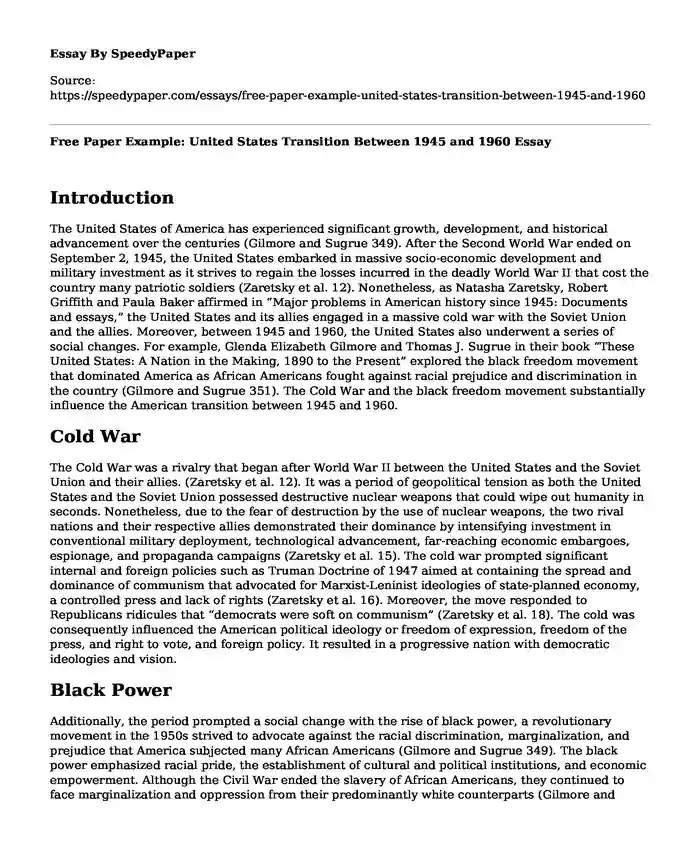
| Type of paper: | Essay |
| Categories: | Politics United States War |
| Pages: | 3 |
| Wordcount: | 787 words |
Introduction
The United States of America has experienced significant growth, development, and historical advancement over the centuries (Gilmore and Sugrue 349). After the Second World War ended on September 2, 1945, the United States embarked in massive socio-economic development and military investment as it strives to regain the losses incurred in the deadly World War II that cost the country many patriotic soldiers (Zaretsky et al. 12). Nonetheless, as Natasha Zaretsky, Robert Griffith and Paula Baker affirmed in “Major problems in American history since 1945: Documents and essays,” the United States and its allies engaged in a massive cold war with the Soviet Union and the allies. Moreover, between 1945 and 1960, the United States also underwent a series of social changes. For example, Glenda Elizabeth Gilmore and Thomas J. Sugrue in their book “These United States: A Nation in the Making, 1890 to the Present” explored the black freedom movement that dominated America as African Americans fought against racial prejudice and discrimination in the country (Gilmore and Sugrue 351). The Cold War and the black freedom movement substantially influence the American transition between 1945 and 1960.
Cold War
The Cold War was a rivalry that began after World War II between the United States and the Soviet Union and their allies. (Zaretsky et al. 12). It was a period of geopolitical tension as both the United States and the Soviet Union possessed destructive nuclear weapons that could wipe out humanity in seconds. Nonetheless, due to the fear of destruction by the use of nuclear weapons, the two rival nations and their respective allies demonstrated their dominance by intensifying investment in conventional military deployment, technological advancement, far-reaching economic embargoes, espionage, and propaganda campaigns (Zaretsky et al. 15). The cold war prompted significant internal and foreign policies such as Truman Doctrine of 1947 aimed at containing the spread and dominance of communism that advocated for Marxist-Leninist ideologies of state-planned economy, a controlled press and lack of rights (Zaretsky et al. 16). Moreover, the move responded to Republicans ridicules that “democrats were soft on communism” (Zaretsky et al. 18). The cold was consequently influenced the American political ideology or freedom of expression, freedom of the press, and right to vote, and foreign policy. It resulted in a progressive nation with democratic ideologies and vision.
Black Power
Additionally, the period prompted a social change with the rise of black power, a revolutionary movement in the 1950s strived to advocate against the racial discrimination, marginalization, and prejudice that America subjected many African Americans (Gilmore and Sugrue 349). The black power emphasized racial pride, the establishment of cultural and political institutions, and economic empowerment. Although the Civil War ended the slavery of African Americans, they continued to face marginalization and oppression from their predominantly white counterparts (Gilmore and Sugrue 351). Moreover, Gilmore and Sugrue recommend “slights the local people who lived in the South and who started the civil rights movement in the 1950s” (Gilmore and Sugrue 354). The constant demonstrations of the black freedom activists, especially during the 1955 Rosa Parks demonstration intensified the campaign against racial segregation in schools, busses, hospitals, churches, and numerous social amenities (Gilmore and Sugrue 353). Such movements and advocacy of the freedom and rights of people of color paved the way for modern civil rights activists such as Martin Luther King Junior who staged a 381-day Montgomery Bus Boycott until the Supreme Court declared segregation unconstitutional (Gilmore and Sugrue 354). Further, “the mainstream interracial groups “did not endorse desegregation.” (Gilmore and Sugrue 355). The continuous advocacy for black freedom and the civil rights of people of color and the marginalized population in America prompted President Eisenhower to sign the Civil Rights Act of 1957 allowing the prosecution of any person who prevents another from voting (Gilmore and Sugrue 355). The voting rights gradually gave African Americans political power and voice as their predominantly white counterparts.
Conclusion
Conclusively, the United States experienced significant transitions between 1945 and 1960. After the active World War II, the country succumbed to a series of internal and foreign policies such as the Truman Doctrine of 1947 to contain the spread of communism and promote capitalism and democracy. Moreover, the rise of the black power movement also instigated a great change in the fight against racial discrimination and marginalization. The civil rights and black freedom movements emphasize political representation, the establishment of cultural institutions, and racial pride to elevate people of color. The movement positively resulted in the enactment of the Civil Rights Act of 1957 prohibiting deterioration from voting.
Works Cited
Zaretsky, Natasha., Baker, Paula., Mark Lawrence., and Robert Griffith, eds. Major problems in American history since 1945: documents and essays. Houghton Mifflin, 2001.
Gilmore, Glenda Elizabeth, and Sugrue J. Thomas. These United States: A Nation in the Making: 1890 to the Present. WW Norton & Company, 2015.
Cite this page
Free Paper Example: United States Transition Between 1945 and 1960. (2024, Jan 07). Retrieved from https://speedypaper.net/essays/free-paper-example-united-states-transition-between-1945-and-1960
Request Removal
If you are the original author of this essay and no longer wish to have it published on the SpeedyPaper website, please click below to request its removal:
- Disability Discrimination Essay Sample
- Residential Racial Segregation and Mortality
- Rawls and Nozick on Gun Violence and Applicable Laws. Free Essay
- Free Essay: Facts and Issues Involved in Muller V Oregon
- Essay Sample on How Mcleod Should Handle Dilemma
- Challenges in Turnaround Strategies for Struggling Schools in the United States - Free Paper Sample
- Free Essay Sample: Libel Defense
Popular categories




